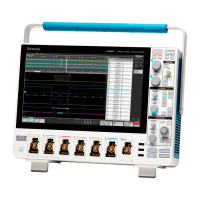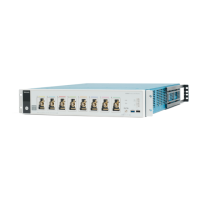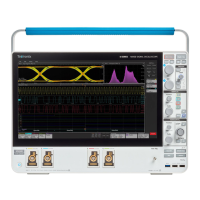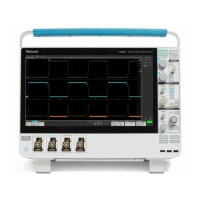3. The level with the most points in the upper histogram is the T
op value, and the level with the most points in the lower histogram is the
Base value.
If Mid gives the largest peak value within the histogram, the oscilloscope returns the Mid value for both Top and Base (this is probably a
very low amplitude waveform).
If more than one histogram level (bin) has the maximum value, the oscilloscope chooses the bin farthest from Mid.
This algorithm does not work well for two-level waveforms with greater than about 100% overshoot.
HighRef, MidRef, LowRef
You set the various reference levels, through the Reference Levels tab of the Measure menu. They include:
High is the waveform high reference level (also HighRef). Used in all measurements. Typically set to 90%. You can set it from 0% to 100%
or to a voltage level.
Mid is the waveform middle reference level (also MidRef). Mid reference levels are used in all measurements that need to find edges.
Typically set to 50%. You can set it from 0% to 100% or to a voltage level.
Low is the waveform low reference level (also LowRef). Used in all measurements. Typically set to 10%. You can set it from 0% to 100%
or to a voltage level.
High, mid and low reference levels can be set uniquely for each measurement source. Reference levels can also be set differently for rising
edge detection and falling edge detection.
Other variables
The instrument also measures several values itself that it uses to help calculate measurements.
Record Length is the number of data points in the time base. You set it with the Horizontal menu Record Length item.
Start is the location of the start of the measurement zone (X-value). It is 0.0 samples unless you are making a gated measurement. When
you use cursor gated measurements, it is the location of the left vertical cursor.
End is the location of the end of the measurement zone (X-value). It is (RecordLength – 1.0) samples unless you are making a gated
measurement. When you use cursor gated measurements, it is the location of the right vertical cursor.
Hysteresis Is the hysteresis band of the waveform amplitude.
For example, once a crossing has been measured in a negative direction, the waveform data must fall below the hysteresis value of
the amplitude from the Mid reference point before the measurement system is armed and ready for a positive crossing. Similarly, after a
positive Mid reference crossing, waveform data must go above the hysteresis value of the amplitude before a negative crossing can be
measured. Hysteresis is useful when you are measuring noisy signals, because it allows the oscilloscope to ignore minor fluctuations in the
signal.
Edge calculations
Edge1, Edge2, and Edge3 refer to the first, second, and third Mid reference edge times, respectively.
An edge can be detected when the waveform is either rising or falling past Midref. The direction of the edges alternates, that is, if Edge1 is
rising, Edge2 will be falling.
A rising edge has positive polarity. A falling edge has negative polarity.
Measurement concepts
244
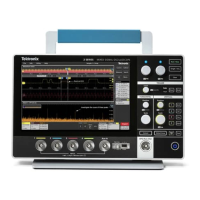
